France is a proud country with a rich history and a vibrant culture, and it welcomes millions of foreign tourists every year.
However, just like anywhere else, if you are unaware of the unwritten rules of etiquette, it can be easy to embarrass yourself or land yourself in trouble.
To help you avoid this – and also hopefully to enrich your knowledge about French life – in this post, I go into detail about French traditions and customs so you don’t find yourself making any cultural gaffes during your visit.
Pro Tip
By the way, if you want to learn French fast and have fun, my top recommendation is French Uncovered which teaches you through StoryLearning®.
With French Uncovered, you’ll use my unique StoryLearning® method to learn French through story…not rules. It’s as fun as it is effective. If you’re ready to get started, click here for a 7-day FREE trial.
Table of Contents
French Religious Festivals
Around 50% of the French population identify as Catholic, with a further 10% belonging to other Christian denominations.
So understandably, Christian religious festivals and their associated traditions feature prominently in the annual cycle of French life.
Here are some of the most important.
1. Christmas
Like in many other countries in Europe and elsewhere, Christmas is among the most important religious festivals in the French calendar – even among non-believers – and there are many traditions related to how Christmas is celebrated.
Unlike in the UK, the main Christmas meal is served in the evening on Christmas Eve rather than in the afternoon of Christmas Day.
In UK culture, eating turkey is all but obligatory, but in France, the choice of what is served is far more open.
Some form of poultry (la volaille) is a common choice. Things like magret de canard (duck breast fillet) or capon (castrated cockerel) are popular options – but turkey is not usually favoured.
However, other meats such as pork or beef can be served instead. By the way, if you want to learn more French food vocab, check out my post on the names of foods in French.
One essential part of the Christmas meal – and one without which it would hardly be Christmas for most French – is foie gras.
It's served before the entrée (starter), usually on warm, thin slices of a special kind of soft bread. It's traditionally accompanied by a white wine that often leans towards the sweeter side of things.
When eating foie gras, never spread it. Instead, place a slice on your bread and eat it like that – it’s a revered delicacy, not some kind of cheap pâté!
Also popular is the bûche de Noël (Yule log), a traditional dessert that exists in the UK too but that is considered more important in France.
Another major difference between Christmas in France and the UK is the tradition of waiting up until midnight on the 24th to exchange presents rather than doing so on the morning of the 25th.
Finally, for believers, it’s also traditional to attend Christmas midnight mass in church on the 24th, a practice that’s followed by many people who otherwise barely step foot inside a church throughout the rest of the year.
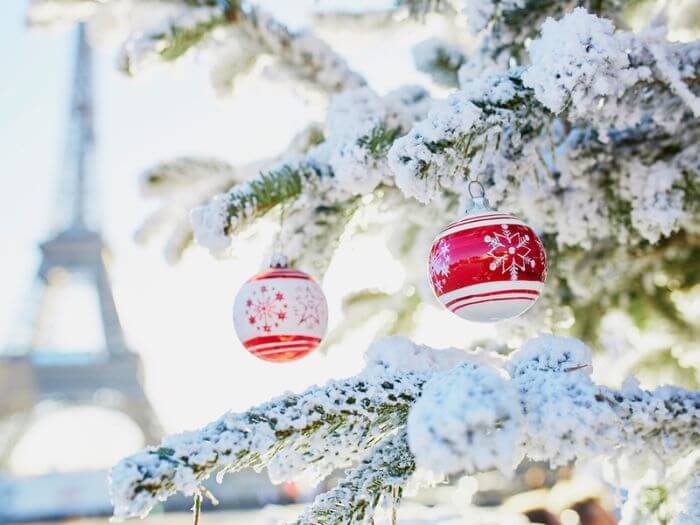
2. Easter
Easter is widely celebrated, and among the traditions associated with this festival is the chasse aux œufs (Easter egg hunt), where adults hide eggs for children to then run around and find.
3. La Toussaint
La Toussaint – or All Saints Day – is celebrated in France on 1st November. The day is a designated national holiday, and traditionally, people visit the graves of relatives to place there a couronne de Toussaint (All Saints wreath) usually made of chrysanthemums.
Incidentally, this is why you should never buy chrysanthemums for somebody as a gift in France since they are associated with death and funerals.
4. Saints’ Days
Every day of the year (other than days like Christmas) is the day of a particular saint. It's customary to wish people a happy saint’s day on the day that corresponds with their first name.
Information about which saint’s day is currently being celebrated is given out during the weather forecast. And according to the custom, you should wish someone a happy saint’s day the day before the day of their saint.
When one of my friends worked in an office in France, she discovered that saints' days were a good excuse for people celebrating their day to bring in a cake, in addition to birthdays!
Other French Festivals And Events
There are several other important festivals in France that are not connected to religion, and here are just two examples.
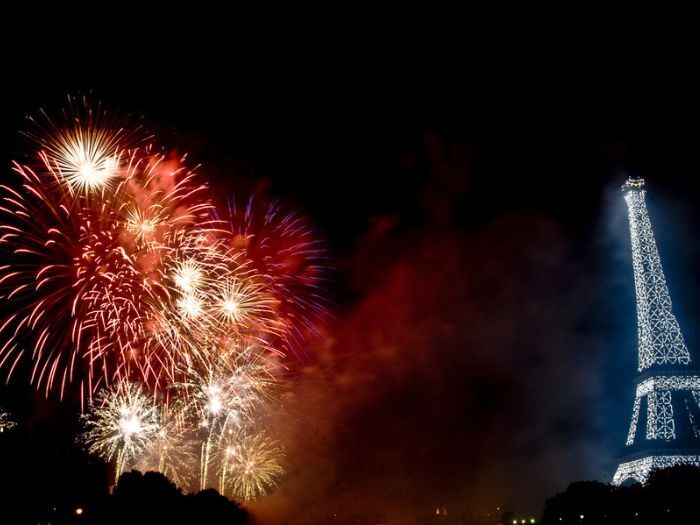
5. Bastille Day
La Fête nationale française or simply le 14 juillet is France’s national day.
In English, it's often referred to as Bastille Day, and it is held to commemorate the Storming of the Bastille during the French Revolution in 1789 as well as the creation of the French Republic more broadly.
Festivities during the day include the pomp and pageantry of the Défilé militaire du 14 juillet (the Bastille Day military parade), outdoor events where traditional food is enjoyed among friends and firework displays after dark.
6. La Fête De La Musique
A more recent addition to the French cultural calendar is the Fête de la musique, known in English simply as Music Day.
On June 21st, people in cities all over France take to the streets to play musical instruments, performing to passersby for free.
Towns and cities often also host free concerts with DJs or live bands, and the whole thing is a joyous and exuberant celebration of all things related to music.
La Fête de las musique has been held in France since its inception in 1982 and has since spread around the world, to date having been adopted by over 120 other countries.
French Culinary Traditions
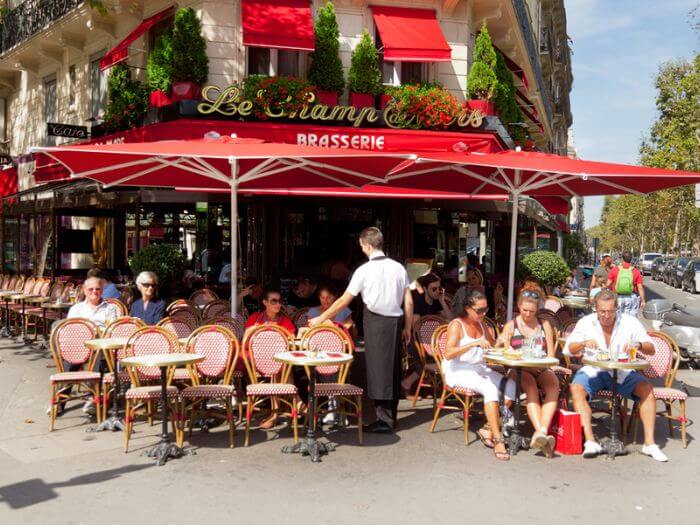
The French are renowned for their passion for food and drink. As such, it should come as no surprise that there are many French customs and traditions associated with dining.
For newcomers to the country, mealtimes can be a cultural minefield if you don’t know about the intricate rules of table etiquette, so let me give you some pointers to help you avoid any culinary faux pas.
7. L’apéro
In France, l’apéro – short for l’apéritif – is the beloved ritual that precedes any meal of consequence or even just a casual dinner with friends.
It involves sharing a drink, some nibbles and good conversation before moving to the table for the serious business of eating.
There are no rules over what you will be served to drink. Traditional options include things like pastis, an aniseed-flavoured spirit that is mixed with water according to taste. But other drinks including whisky, rum or anything else (with or without a mixer) may be offered.
Snacks as simple as a bowl of crisps (“potato chips” for my American readers!) may be provided, but other morsels such as saucisson (dry-cured sausage), olives and more elaborate items are also common.
Just make sure you don’t eat too much – because the main meal hasn’t even begun!
8. The Order Of Play
French meals follow a fixed pattern, and the dishes come out in a set order – although some may be skipped, depending on the importance of the event.
That said, even if you are invited to a friend’s house for a casual meal, you can expect most of the following dishes to be included in some form.
L’Entrée
After l’apéro, the meal usually starts with an entrée or starter, a smaller, lighter dish that may be based on meat, poultry, fish, shellfish or just about anything else.
Le Plat Principal
This is then followed by the plat or plat principal – the main dish. This is likely to feature something more consistent, perhaps a piece of meat or fish accompanied by vegetables and potatoes.
Depending on the formality of the meal, you may even be served different wines with the entrée and the plat – although this is more likely for things like the Christmas meal.
La Salade
After the plat, you may be offered some salade. This usually means just some lettuce leaves with salad dressing, which serves to rincer la bouche (rinse/wash the mouth) before the cheese and dessert courses.
In French, salade means both “salad” in the English sense of a mixed salad and also just “lettuce”. You may be served a mixed salad as an entrée – such as a salade niçoise – but after the main dish, you will usually just be given lettuce.
Le Fromage
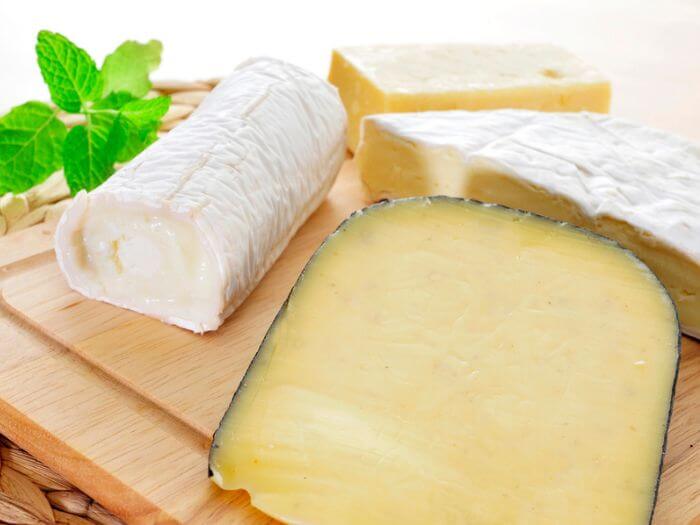
After the salad – which you can feel free to decline – comes le fromage, the cheese. The French are almost as proud of their bewildering array of regional cheeses as they are of their wines, and a plate will normally appear with at least three or four different varieties.
Unlike in the UK, cheese is not considered a dessert option in France – the cheese precedes the dessert.
Cheese is eaten with bread, and the running joke that almost always gets trotted out at every mealtime is that you just need a bit more cheese to finish your bread. And then you need a bit more wine to finish your cheese. And then more bread and cheese for your wine…
It’s always a great excuse to keep serving yourself more cheese, bread and wine until you’ve had enough!
Le Dessert, Le Digestif, Le Café
When you’ve had your fill of cheese, the dessert will be brought out, and after this, you may also be offered a digestif, a small glass of something like cognac, armagnac in the south-west or calvados, an apple-based spirit, in Normandy.
Finally, to finish it all off, you may then also drink a cup of coffee.
9. Wait For Everyone To Be Served Before Starting To Eat
An important point of etiquette to observe when eating in France is that you should never start eating before everybody is served. This is also the case in the UK and other places, but in France, they adhere to it more strictly than us Brits.
When everybody is served, you should then all wish each other bon appétit! – or the more informal bon ap! – after which you can dig in. By the way, if you want to learn more informal expressions like bon ap, check out this post on French slang words.
10. Cutlery
In France, you should eat with the knife in the right hand and the fork in the left hand with the prongs pointing down.
It would be considered uncivilised to hold the fork in the right hand and use it to spoon food into your mouth with the prongs pointing up in the American style.
While you are eating, if you want to take a break, etiquette dictates that you should place your knife and fork apart on the plate in the 4 o’clock and 8 o’clock positions.
You can then indicate that you have finished eating by placing the knife and fork together on your plate, either vertically or at a 45° angle.
11. Hands And Elbows
Especially in more formal settings, you shouldn’t place your hands below the table, and you shouldn’t place your elbows on the table. However, among good friends in an informal setting, you can probably get away with doing this.
12. Bread
French meals are normally served with bread. You can place your piece of bread on the table by the side of your plate since the table will be covered with a clean tablecloth.
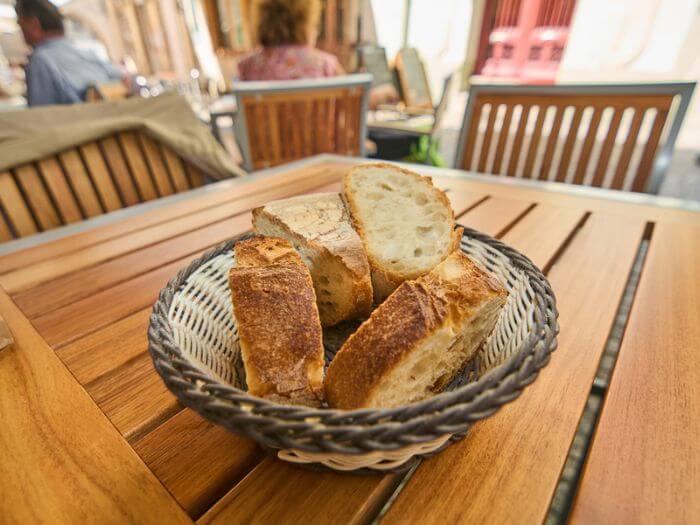
13. Don’t Cut The Lettuce!
One interesting rule that non-French might easily miss is that it’s considered rude to cut lettuce. Lettuce will usually be served in a salad bowl already torn into small enough pieces to eat.
However, once the lettuce is on your plate, rather than cut it into even smaller pieces, you should use your knife and fork to fold it over until you can fit it into your mouth.
14. Tipping
In France, tipping is not obligatory, so Americans visiting the country shouldn’t feel they have to hand over the customary 15-20% that they do back home.
However, leaving a few coins for a modest meal and up to 10% for something more substantial is always appreciated if you feel the person serving you has done a particularly good job.
15. When To Arrive
If you’re invited to somebody’s house, make sure you don’t arrive early – because they might still be preparing for your visit, so they won’t be ready to receive you.
In fact, if they’re running late in their preparations, even arriving precisely on time might put them out. So to be safe, it’s best to arrive around 10 to 15 minutes late.
Be aware, however, that this doesn’t apply when you’re meeting somebody for a meal in a restaurant. In this case, you should arrive at the appointed time, or they may end up standing there waiting for you.
At The Bar In France
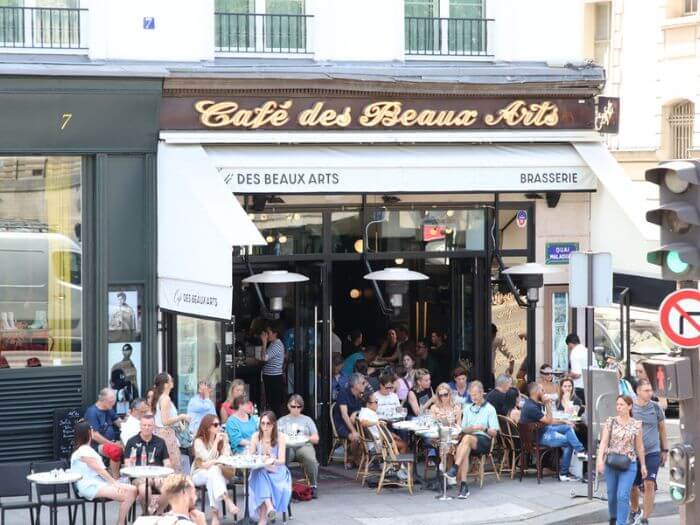
Especially for Brits, French bar culture can seem a bit different from what they’re used to back home. Here are a few customs in France that you need to be aware of if you're invited out for a drink.
16. Wait For Everyone To Arrive
If you arrange to meet your friends to go to a bar, ideally, you should wait outside until everybody arrives. But at the very least, you should sit down and wait for everybody to get there before your order.
This is quite different to how things are in the UK where you would normally go in, order a drink and sit there sipping it while you wait for the rest of your party to turn up.
17. Wait For Everyone To Be Served
Once everyone is there, you’ve sat down at your table and ordered your drinks, you should then wait for everybody’s drink to arrive before you start.
Again, in the UK, people usually grab their drinks as soon as they come and start sipping away – but in France, this is considered bad form.
18. Saying Cheers
So everybody’s there and you’ve all got your drinks – but you still need to wait a bit longer.
This is because before you can drink, you need to touch glasses with everyone – trinquer in French.
When you do this, you shouldn’t go over or under the arms of others, so if there are lots of people, you might need to be patient.
It’s also important to make sure you trinque with everyone individually rather than everybody just putting their glasses into the middle at once, as might happen in the UK. When you touch glasses with each person, be sure to look them in the eye.
There are different ways of saying “cheers” in French. The standard word is santé, which means “health”. Alternatively, you can say à la tienne/à la vôtre –or with friends, you can use the more informal tchin or tchin-tchin.
Greeting People In France
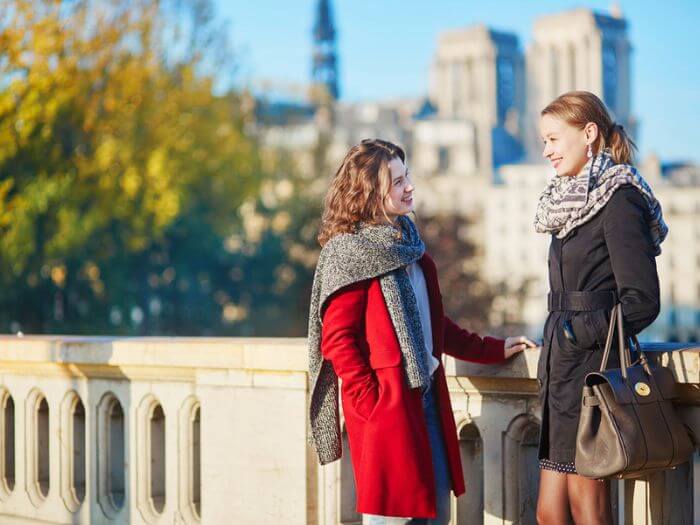
Even something simple as saying hello or goodbye to somebody in France can lead to cultural mistakes, so here’s a quick guide to the dos and don’ts of French greetings.
19. La Bise And Shaking Hands
When two males greet each other, it’s normal for them to shake hands, and this is just as true in a formal context as it is with your good friends. Not shaking hands when greeting someone would be seen as rude.
When two females who are on friendly terms greet each other, it’s normal to perform la bise, the action of giving each other a small kiss on each cheek. The same is true when a male and female who are on friendly terms greet one another.
On the other hand, in a formal or business setting, it’s customary to shake hands, whether it’s two males, a male and a female or two females – something you would expect to repeat every morning when you arrive in the office.
With family members or very close friends, it’s also possible for two males to perform la bise.
La bise is most commonly done with a kiss to the right cheek first and then one to the left – although in some regions, the inverse is true. More rarely, a triple kiss is performed.
20. Taking Your Leave
When taking your leave of somebody, the same rules apply. So if you shook somebody’s hand or performed la bise when you greeted them, you should do the same when you say goodbye.
When saying goodbye to a group of people, it’s normal to go round and perform la bise or shake everybody’s hand individually. You can’t simply announce to everyone that you’re off, give the group a wave and leave.
21. Saying Hello In Shops
When you walk into a small shop, it’s usual to greet the shopkeeper by at least saying bonjour – a simple nod of the head won’t do. Similarly, you should also say au revoir when you leave.
However, in such situations, shaking the shopkeeper’s hand would certainly not be expected!
22. French Formality And Distance
In general, the French don’t make idle conversation as much as people from the UK or Americans. So engaging in chit-chat with shopkeepers you don’t know while you pay is not expected.
Indeed, if a shopkeeper is particularly talkative, after leaving the shop, somebody might remark disapprovingly that elle est gentile, mais elle me racontait un peu sa vie! – which could be translated as “she was nice, but she was telling me all about her whole life story!”
As a rule, the French are more formal and distant with people they don’t know than Brits or Americans. And this is according to French people I know, so I don’t have any qualms about repeating it here!
French Sport
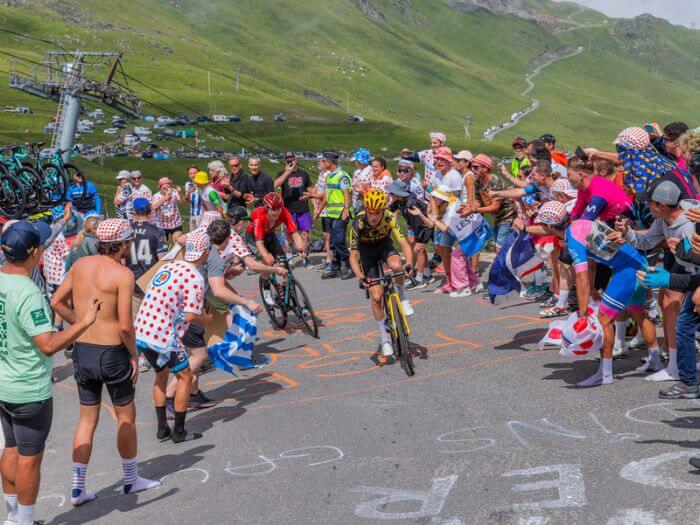
The French love their sport – and British fans might complain that they’re infuriatingly good at it. Here are some of the French sporting traditions to know about.
23. Football, Rugby, Tennis
In France, football and rugby are among the most watched sports – the south is the traditional heartland of rugby, but now its popularity has spread throughout the country.
The French also enjoy other sports like handball (le hand), basketball (le basket) and ice hockey (le hockey).
Tennis is another popular sport, and “Roland-Garros”, the name of the stadium that hosts the annual French Open, resonates with French people in much the same way that “Wimbledon” does with people from the UK.
24. The Tour de France
The yearly Tour de France is one of the country’s most famous and iconic sporting events and is eagerly watched by many French each summer.
It is the oldest of the three Grand Tours and is also the most prestigious. Other than during the two World Wars, it has been held every year since 1903.
It is an event rich in history and lore, and it has become a part of the French cultural identity, even for those with no interest in sport.
25. Pétanque
Pétanque is the quintessential French game that revolves around throwing metal boules and trying to get them to land as close to the cochonnet (jack) as possible.
To this day, old – and young – French can be found playing the game in village squares, on dirt paths, on the beach or on any other makeshift terrains.
It’s a great activity for spending time with friends or perhaps making new ones, and if you’re any good at it, you’re sure to impress the locals. Just be warned – sometimes things can get quite competitive!

French Superstitions
Like most other countries, France has its own superstitions, which may or may not be shared by their Anglo-Saxon or other neighbours. Here are a couple of the more interesting ones.
26. Stepping In Dog Poo
In the UK, it’s considered lucky if a bird poos on you (as it is in France). However, in France it’s also considered lucky if you step in dog poo – but only if you do so with your left foot.
27. The Number 13 And Friday 13th
Just as in English-speaking countries, the number 13 is considered unlucky in France – and Friday 13th is considered an unlucky date.
However, nowadays, the French have turned this on its head – because every Friday 13th, the French lottery offers extra-big prizes, so for some people at least, the day will turn out to be far from unlucky.
28. Don’t Place A Baguette Upside-Down
One superstition to be aware of in France is that you should never place a baguette upside-down.
This comes from a practice that dates back to the Middle Ages when bakers used to leave bread for the executioner.
The executioner’s bread was turned over so that everyone would know who it was for. And as a result, placing a baguette upside-down has come to be seen as extremely unlucky.
French Cultural References

Sometimes, even when you reach a high level of proficiency in a language, you can still find yourself baffled by native speakers talking among themselves because you can’t pick up on all the cultural references they’re using.
This is something that’s hard to learn without spending time in the country or being surrounded by native speakers. But here, at least, is an idea of the kind of thing you need to learn about if you want to really immerse yourself in modern French culture and traditions.
29. BD
BD – or bande dessinée, French comic strips – is a major part of modern French (and also Belgian) culture, and most French grow up reading them.
Everyone knows the classics like Tintin, but there are many others that are less famous outside France. And reading BDs is a great way to improve your French.
The StoryLearning method is all about reading interesting material at your level, and reading French comics (or short stories in French) is a great way to do that.
Watch me talk about BD and other French books for beginners in the video below.
30. Stand-Up Comedy And Sketches
The French are also big fans of stand-up comedy, and there is a major national radio station called Rire & Chansons (Laughter and Songs) dedicated to playing famous sketchs (sketches or skits) on repeat until the audience knows them by heart.
Among the most famous artists are the French-Moroccan Jamel Debbouze, Florence Foresti, Jeremy Ferrari and Elodie Poux.
In French, they don’t talk about “stand-up comedy” – they use the term one-man-show!
31. French Cinema

France is known as the birthplace of cinema, and although Hollywood now consistently churns out the highest-grossing blockbusters, French films tend to be more cerebral or thought-provoking.
Famous stars of the silver screen include Sophie Marceau, who, as well as appearing in English-language films like Braveheart and the Bond movie The World Is Not Enough, has also featured in a large number of French-language productions.
Audrey Tautou is best known outside of France for her appearance in Amélie, known in France as Le fabuleux destin d’Amélie Poulain (The Fabulous Destiny of Amélie Poulain).
However, she has also appeared in several other excellent films that are less famous outside of France – two of my favourites are À la folie…pas du tout (in English, called He Loves Me, He Loves Me Not) and Hors de prix (known in English as Priceless).
Her co-star in Hors de prix was Gad Elmaleh, a Moroccan-Canadian actor and comedian who has previously also worked with Jamel Debbouze.
Marion Cotillard is another famous name in France who is best known in the English-speaking world for her role as Édith Piaf in La Vie en Rose (a film known in France as La Môme).
However, among many others, she also appeared in the Taxi franchise (the original film was released in 1998), a phenomenon of popular cultural that people still quote to this day.
French Traditions: Try To Avoid Mistakes, But Don't Worry
From this post, you might think that your trip to France is going to be a lot more complicated than you’d expected. But try not to worry too much. Above all, don't let the fear villain hold you back from participating in traditions and culture in France.
The best advice is just to be as culturally aware as you can and to take the lead from those around you.
And beyond that, to keep your sense of humour, because people will forgive you for any errors you commit. And cultural missteps can often end up being rather funny anyway!
If you still want a bit more help to get your head around French traditions and culture, you can enrol in my course, French Uncovered. In the course, you'll learn French thanks to an entertaining story and you'll get lessons about French culture. Click here for your free 7-day trial.

Olly Richards
Creator of the StoryLearning® Method
Olly Richards is a renowned polyglot and language learning expert with over 15 years of experience teaching millions through his innovative StoryLearning® method. He is the creator of StoryLearning, one of the world's largest language learning blogs with 500,000+ monthly readers.
Olly has authored 30+ language learning books and courses, including the bestselling "Short Stories" series published by Teach Yourself.
When not developing new teaching methods, Richards practices what he preaches—he speaks 8 languages fluently and continues learning new ones through his own methodology.










































